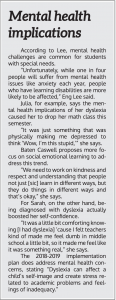“I just generally thought I was stupid .… I would take shorter spelling tests. We would get 15 questions and I would have five and I would get all of those wrong — literally all of them,” says Julia, a Palo Alto High School junior whose name, like others in this story, has been changed to protect her identity.
Although Julia says she always knew she had dyslexia and attention-deficit/hyperactivity disorder, she didn’t realize the severity of her learning disabilities until fourth grade when she qualified for an Individualized Education Program — a plan that can provide students with learning disabilities with educational interventions — with some help from her mom, who already had two other children with learning differences.
“By the time I went into middle school, I was pretty close to being average [academically],” she says. “But then it started really affecting my math skills, and then I would be in special education math classes.”
Although Palo Alto Unified School District has more funding and support for students with dyslexia than most, Julia says it has not always provided adequate resources to fully support her and other students. While she is incredibly grateful for her district-provided case manager, who helps her select things like classes and future colleges, she has not always felt so well resourced.
“I had to go to speech impediment classes because they didn’t have anything for how bad my dyslexia was,” Julia says. “They didn’t have any programs designed for people who had as severe dyslexia as me as that young an age.”
Improving horizons
According to Yolanda Conaway, the Assistant Superintendent for Strategic Initiatives, the district has plans to improve the educational accommodations given to students like Julia.
In November 2017, district educators, administrators, staff specialists and parent representatives formed the PAUSD Dyslexia Workgroup to review the needs of students with dyslexia and comply with AB 1369, a new state law requiring schools to better support these students.
“The workgroup was really intended to make sure that we have a multidisciplinary group of people on the team and that we got parents feedback as well,” Conaway says. “This is a really good opportunity to hear the voices of the community.”
In January 2018, the group presented the 2018-2019 Dyslexia Guidelines Implementation Plan, or The Dyslexia Plan, to the Board of Education. The plan proposes an estimated total of $192,000 to $212,000 of district funding be spent on initiatives such as staff trainings and universal dyslexia screening for elementary school students.
The plan lists four priorities — shared awareness, universal early screening, response development and other interventions — with a focus on early identification and intervention.
“Early readers tend to better across the board so the earlier we can get kids [reading] … the better outcomes overall,” Conaway says.
“Getting more kids reading is a game-changer.”
— Kimberley Eng Lee, CAC Chair
Over the past year, the workgroup has refined the plan and trained every PAUSD teacher in identifying and supporting students with dyslexia.
“We’re basically waiting for approval to move to the next phase of that,” Conaway says. “It’s probably not as quickly as one person dedicated to it would have done, but we certainly are moving at a steady pace.”
Although some support for students with dyslexia are available across the district, the underachieving students are often those who have not yet been officially diagnosed. Furthermore, Emmett, a senior with dyslexia, says it would cost approximately $15,000 to test for the types of diagnoses the district accepts to qualify him for accommodations, which his family cannot afford.
“I was able to get that for totally free but only in my junior year because it takes forever for it to go through,” he says.
For families whose children the district chooses not to test, private testing may not be an option to due excessive financial pressures.

Accommodations
Currently, most students who are diagnosed with dyslexia receive various accommodations ranging from extended testing time to extra reading supports, such as an aid to read material aloud.
“Accommodations do not change academic standards or expectations, but they make it possible for students with dyslexia to demonstrate their learning without being hindered by their disabilities,” stated Kimberly Eng Lee, chair of the Community Advisory Committee for Special Education.
However, despite existing measures, Board of Education Trustee Melissa Baten Caswell says she has witnessed numerous families of students with dyslexia leave the district for more specialized private schools.
“We’re [PAUSD and other Santa Clara County School districts] all spending a lot of money on it, but we’re not having the kind of results that we would like to have,” she says.
Dyslexia defined
According to the 2018-2019 Dyslexia Guidelines Implementation Plan, one in five students has some form of dyslexia, a learning disability that the Mayo Clinic defines as “a learning disorder that involves difficulty reading due to problems identifying speech sounds and learning how they relate to letters and words”.
“It’s nice to know that you aren’t alone,” says Sarah, a senior with dyslexia. “Especially at Paly, I feel like kids are very open about it.”
Sarah says she was diagnosed in eighth grade after years of showing markers of dyslexia, such as having difficulty with writing and consistently moving down math lanes.
“I got really frustrated so I went to the office and I asked if I could get tested in eighth grade and that was when … I found out,” she says.
Once she was placed on a 504 Plan, which provides accommodations for students identified with a disability, she says she has received only support from the district. However, she believes if her symptoms were recognized earlier, she could have had more academic success.
“If you read my writing and stuff and do the math it was very obvious that there was something missing and I think that if I had help earlier on I could have stayed in higher lanes,” Sarah says.
Emmett moved to the district for freshman year and says he only received his diagnoses of dyslexia, ADHD and dysgraphia at the end of his junior year.
“It’s an extremely late diagnosis … it’s nice to know now,” he says.
“It’s nice to know that you aren’t alone.”
— Sarah, senior
Baten Caswell says she would like to see more focus on students like Sarah and Emmett in the Dyslexia Plan.
“We should be testing for this at every level — this is not just early intervention,” Baten Caswell says.
Baten Caswell supports these initiatives, noting the efforts to universally screen students for dyslexia at a young age.
“[So hopefully] we’ll have less kids going into Special Ed because we’d be able to put them into general reading supports,” she says.
However, some community members have expressed concerns over the plan’s heavy focus on early childhood identification and interventions but lack of procedure for older students.

“Given the number of students first identified during middle and high school, the plans do not clearly address how secondary students will receive adequate instruction time or coordinated accommodations,” Eng Lee stated.
However, after attending the March 13 board meeting, Eng Lee says the committee notes community concerns and is now working to include older students in the plan.
“There were big wins for dyslexia at the Board Meeting,” she stated.
Conaway says despite the focus on early interventions, older students with dyslexia will still benefit from the plan.
“The awareness alone makes people pay attention and when educators are paying attention they are able to see signs of things that concern them,” she says.
Julia adds that the plan is especially pertinent to students with dyslexia who remain undiagnosed and lack supports because of a lack of widespread parent awareness of learning disabilities.
“I think there does need to be a plan put in place for kids whose parents have refused to get them diagnosed, whose kids are just now developing because school is getting harder,” she says. “Just to make it more even and more fair for kids who are having a harder time in school based off of learning disabilities.”
Priority 1 of the plan addresses community and parent education, stating strategies such as informational meetings about possible general education interventions and education about ways parents can inform teachers if they suspect their child has a learning disability.
According to Conaway, the two parent education forums generated a lot of parent interest in helping the dyslexia workgroup.
“The parents that came were actually pretty knowledgeable about that [dyslexia],” she says. “We had to address the needs of everyone who came in so it was just talking about what is dyslexia and how we go about identifying it, and then how we go about intervening to meet the needs.”
Although the board has not yet been presented with a substantial update on the plan, Baten Caswell says she expects teacher training to be a large part of it. According to her, the plan will not focus on in-depth teacher training for supporting students with dyslexia but will instead provide information on identifying students with dyslexia and finding them outside support.
“Our responsibility is to ensure that we make sure that everyone knows what dyslexia is, understands the warning signs [dyslexia identification] … and what can teachers do to accommodate students in the classroom, but also to understand the referral process for identification and just kind of just training across the district,” Rita Rodriguez, Addison Elementary Psychologist and workgroup member says.
“I think in middle and high school, it’s really important for them [teachers] … to pay attention to it [markers of dyslexia] because I’ve seen kids that have this problem be taught strategies, and then be successful in high school,” Baten Caswell said. “We just have to be providing this [supports]. Just telling people, ‘Oh, yeah, we’ll put you on an IEP,’ doesn’t really solve the problem.”

Unique thinkers
Eng Lee says the plan could be also improved with a deeper focus on the many strengths of students with dyslexia to acknowledge that dyslexia is not just a complication.
“I’d love to see effort demonstrating and building the strengths/assets of dyslexic people among students, teachers and parents,” Eng Lee stated. “So often, dyslexic students are endowed with significant right-brained skills that get overlooked because of their difficulty reading, spelling or demonstrating comprehension. Many don’t feel good about themselves, or about school and learning.”
Though Julia says she initially struggled with adverse social reactions to her dyslexia, this prompted her to reflect on her different learning style.
“Having ADHD to me is like a blessing in and of itself because like I think so differently than everyone else,” she said. “[The] majority of famous athletes have severe ADHD. There’s so many famous people [that are neurodiverse].”
Julia also says she is grateful to her IEP case manager for helps her to select classes and identify colleges with the best services for students with learning disabilities.
“My case manager is the nicest woman ever, helps me through everything .… That’s not something that you will find at other schools necessarily because it’s just above and beyond,” she says.
Eng Lee says she is confident the plan will be a significant improvement for the district and many students with dyslexia.
“That the Board is asking for a dyslexia update is a very good sign,” she wrote. “Getting more kids reading is a game-changer.”
According to Conaway and Rodriguez, the workgroup will continue to refine the plan until it is once again presented to the board.
“We’ve been very fortunate that we’ve gotten pretty much universal support from the board as well as from the community,” Conaway says.



